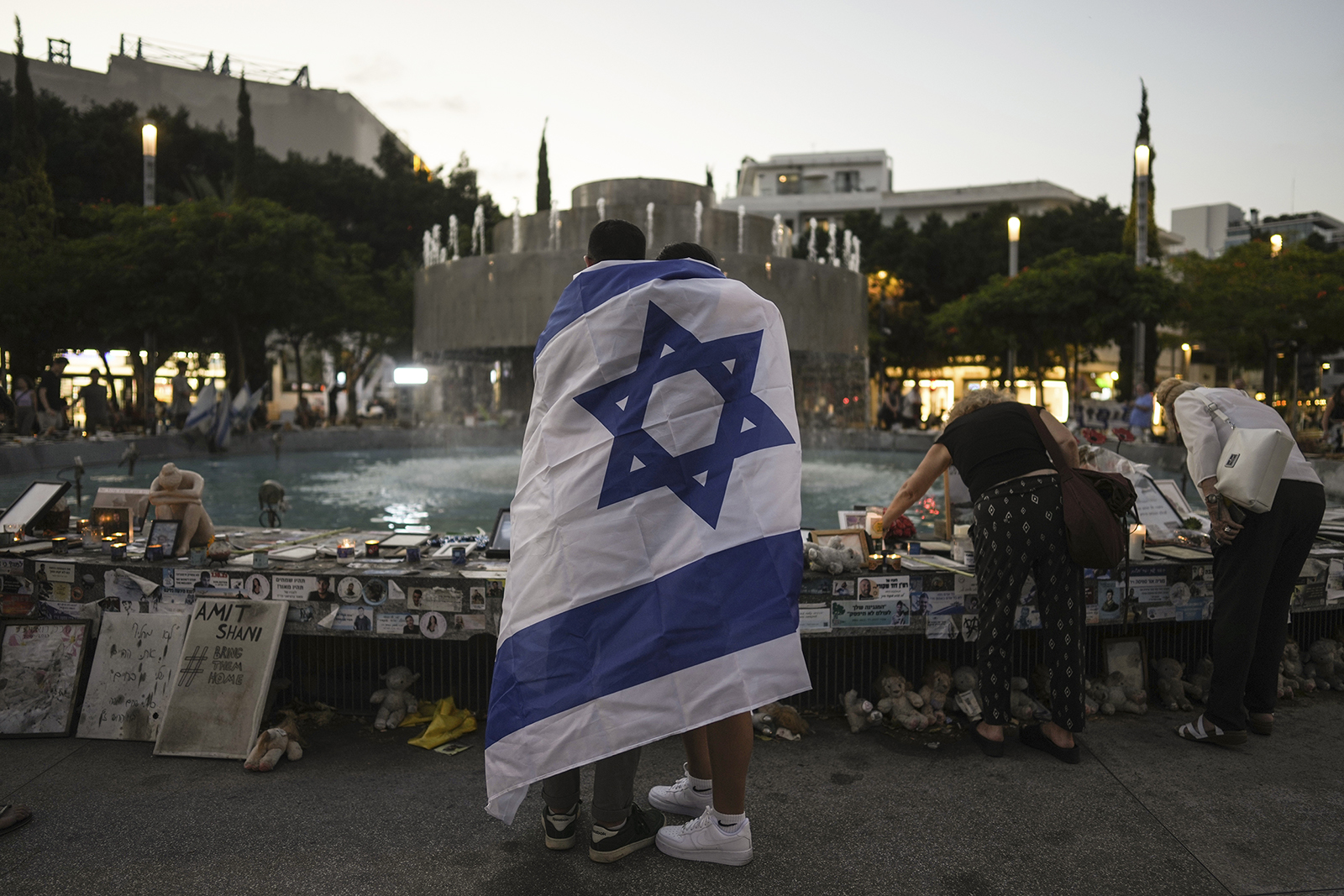
JERUSALEM (RNS) — After the Oct. 7, 2023, Hamas massacre, many Jews and their allies around the world started reciting special prayers for the release of the hostages held by Hamas. They’ve worn dog tags reading “Bring Them Home” and yellow-ribbon pins in solidarity with the hostages’ families.
At the urging of Rachel Goldberg-Polin, the mother of slain Israeli-American hostage Hersh Goldberg-Polin, many have worn a piece of masking tape inscribed with the number of days since the hostages were kidnapped.
With the recent return of all living hostages, and all but three of the bodies of deceased hostages, a question has emerged: What should be done with these deeply valued symbols and rituals that have played a central role in the lives of Israeli and diaspora Jews over more than two years?
Many have also questioned how to mark this hopeful turning point while appropriately remembering in perpetuity those who suffered and died.
“These symbols represent the struggle and pain and trauma that Jews have been going through,” said Rabbi Anina Dassa, a rabbinic fellow at the Adas Israel Congregation, a Conservative synagogue in Washington, D.C. “Throwing them out would be doing a disservice and would not allow us to do the healing we need to do. And because these objects carry so much weight, we must think intentionally about what to do with them.”
Some are starting to figure it out. For example, Rachel Selby, an educator based in Jerusalem, said she adopted new rituals in the wake of the Hamas attack that she now plans to keep.
“I light a yartzheit (memorial) candle on Oct. 7, as we do on Holocaust remembrance day and memorial day. I think all three days should be fast days,” Selby said, adding that she has moved the yellow hostage pin she wore every day to the display cabinet in her home.
Liat Collins, a Jerusalem-based journalist, said she will continue her family’s longstanding ritual of leaving an empty place at their Passover table in honor of those still missing. Even if the bodies of the three remaining hostages are returned, she said, “there are still missing soldiers from previous wars.”
Jewish communities have long incorporated Jewish historical moments into their calendars, ensuring that significant events are remembered through generations. For instance, many congregations include in their memorial prayers Holocaust victims and fallen Israel Defense Forces soldiers. In Israel and abroad, most synagogues also hold events for Israel’s annual Holocaust remembrance day, Yom Hashoah; Israel memorial day, Yom Hazikaron; and independence day, Yom Ha’atzmaut. Now, they also pray for the 1,200 people killed on Oct. 7.
“Of course, we are not the first generation of Jews faced with the responsibility of incorporating some new event in Jewish history into our calendar, and in so doing, turn Jewish history into enduring Jewish memory,” Rabbi David Wolkenfeld of Ohev Sholom Congregation, an Orthodox shul in Washington, said in a sermon on the second Hebrew anniversary of the Hamas massacre.
Soon after Oct. 7, the Sutton Place Synagogue in Manhattan placed prayers, written by the Conservative congregation’s children, on the walls of the sanctuary. An Israeli flag featuring a yellow ribbon was draped over a chair on the bimah, the raised platform in the sanctuary where the rabbi and cantor recite prayers. And like many synagogues around the world, the congregation added Acheinu — a haunting ancient prayer that pleads with God to safeguard Jews in captivity and peril — into their regular prayers.
In mid-October 2025, when the last of the living hostages were freed, the synagogue’s leadership deliberated over the best way to celebrate the milestone. In an emotional ceremony, Rabbi Rachel Ain moved the Israeli flag with the yellow ribbon from the bimah chair to the back of the sanctuary as the cantor chanted Acheinu. The children’s prayers were transferred as well.
Ain said the ceremony marked a turning point for her congregation. “By moving the hostage flag from the bimah we were able to reclaim the space, transforming it into a space of joy without forgetting the pain the hostages and their families endured since October 7.”

People react as they gather to watch a live broadcast of Israeli hostages released from Gaza at a plaza known as hostages square in Tel Aviv, Israel, Oct. 13, 2025. The release took place as part of a ceasefire agreement between Israel and Hamas. (AP Photo/Oded Balilty)
But it was also a way for the synagogue to preserve and honor some of the symbols and artifacts Jews have embraced during the war. “For me, the thought of throwing out the symbols didn’t feel right,” Ain said, “but keeping them in the place they were in didn’t feel right either because there had been a shift.”
The release of the living hostages prompted the Adas Israel Congregation to accept an offer from artist Rachel Farbiarz, a member of the synagogue, to gift a piece of artwork that will serve as a memorial and repository for cherished symbols related to the war.
“People in our community wanted to do something to mark this transition and preserve these symbols, but didn’t know what,” said Dassa, the rabbi overseeing the art project. “We are exploring how to move through this period and to find healing as a community.”
Although Farbiarz has not yet decided on her project’s final details, she has created a receptacle, known as genizah in Hebrew, where community members can bring their hostage pins and other related belongings. A genizah traditionally serves as a place where Jews put worn Jewish prayerbooks and other no-longer-usable sacred objects that must be ritually buried instead of thrown away, according to Jewish law.
“I noticed that for both myself and many of my friends and community, there is a desire to move through this time, but not knowing what to do with these artifacts,” Farbiarz said. “Each of us in our own way invested these objects with attachment, and now there’s a real ambivalence about items that are sacred to us.”
The project is not Farbiarz’s first artwork on the theme. “The Geniza Project,” one of her earlier works, was a life-size installation of a messy office. On closer inspection, the artwork contains everyday objects like photographs, diary pages and greeting cards once owned by people who lived and worked in Washington, D.C., aiming to capture personal histories from the district.
Like other Jewish ritual items, Farbiarz will handle the hostage-related items “in a way befitting their holiness,” she said, adding that it is “powerful” to see the receptacle fill up. “My hope is to make a permanent fixture for the community. What I create will depend on what I receive.”
